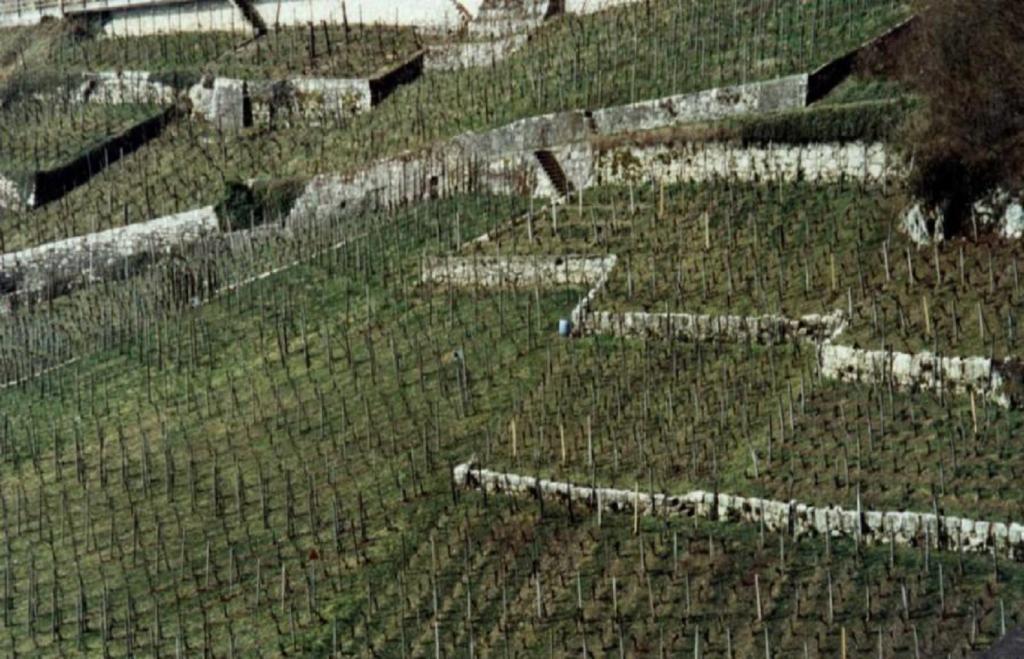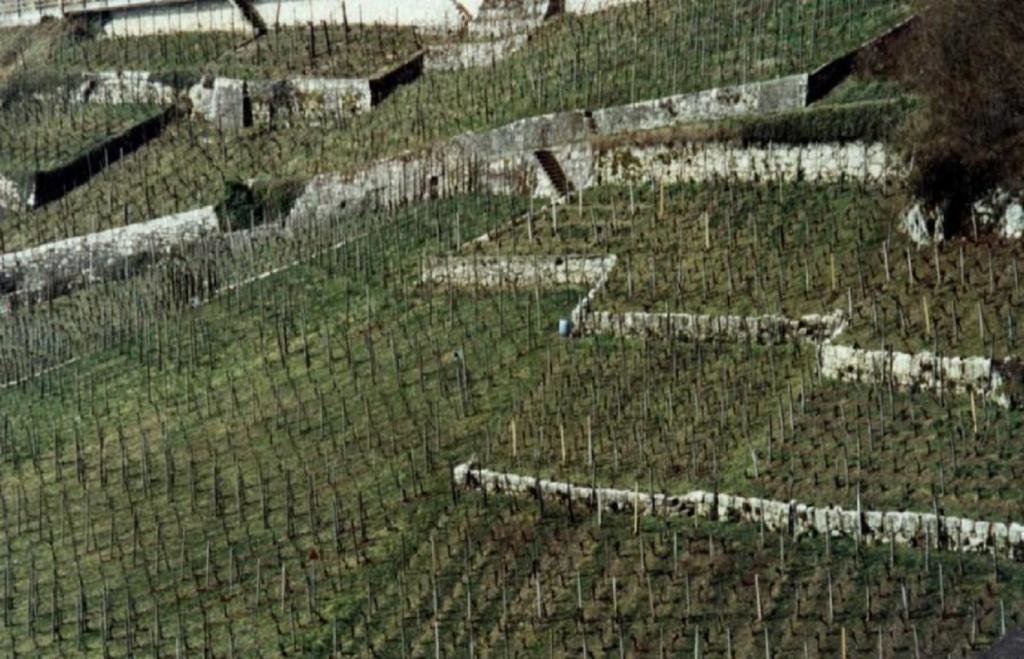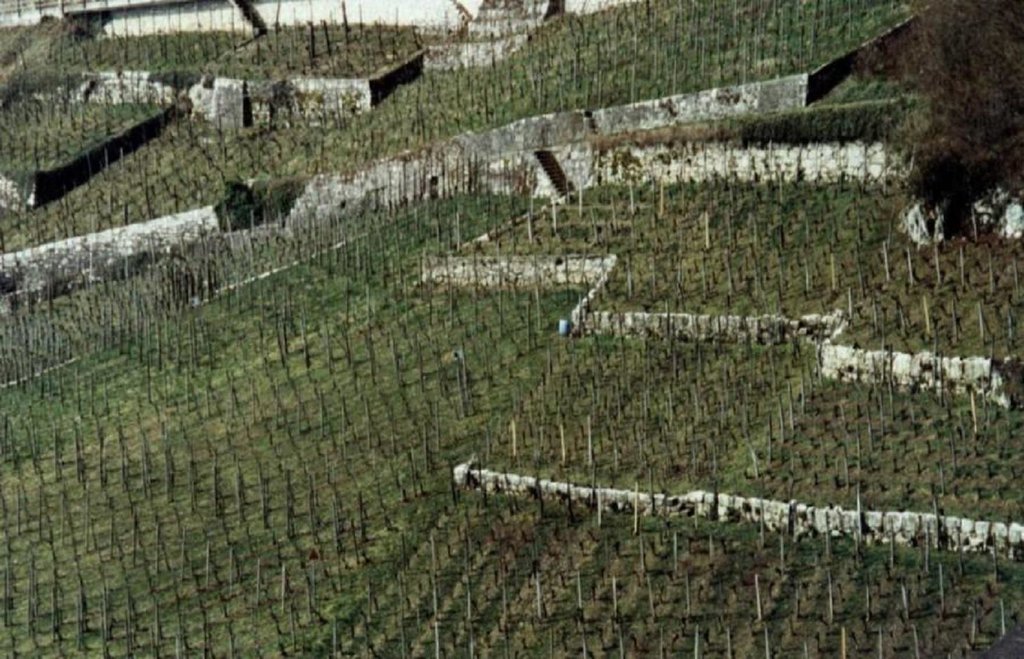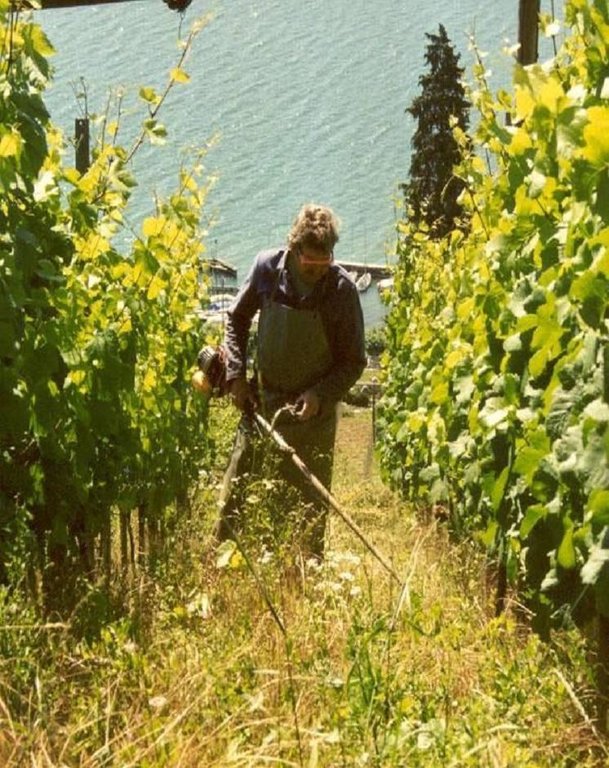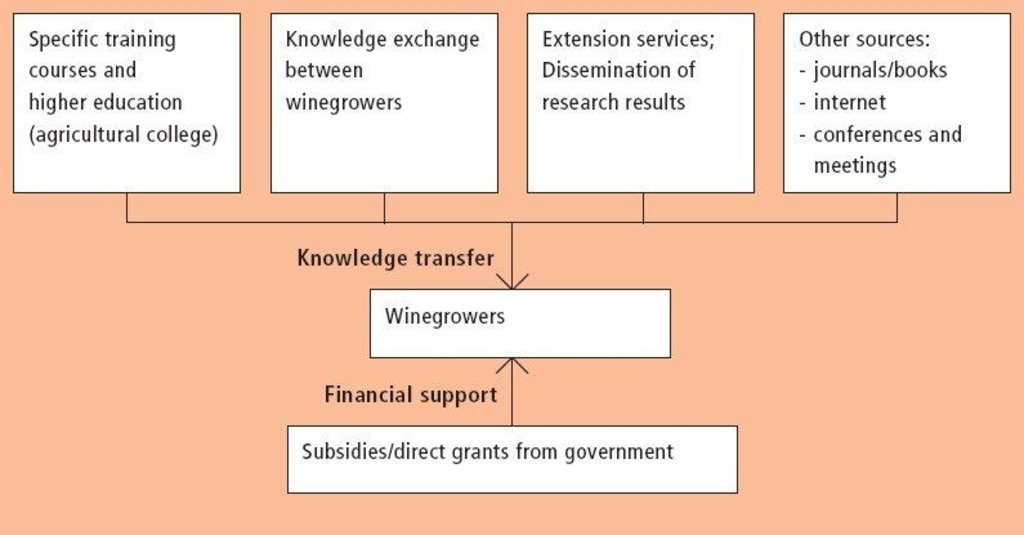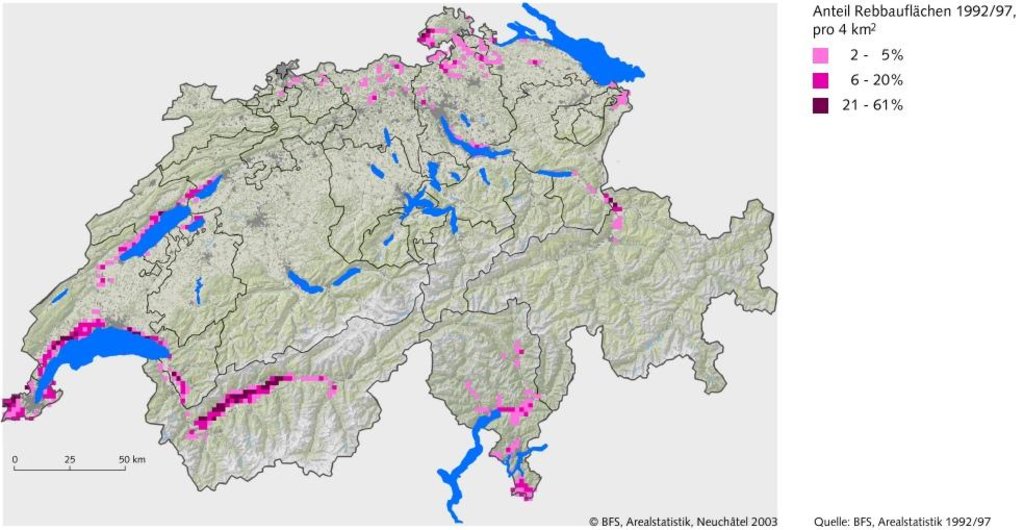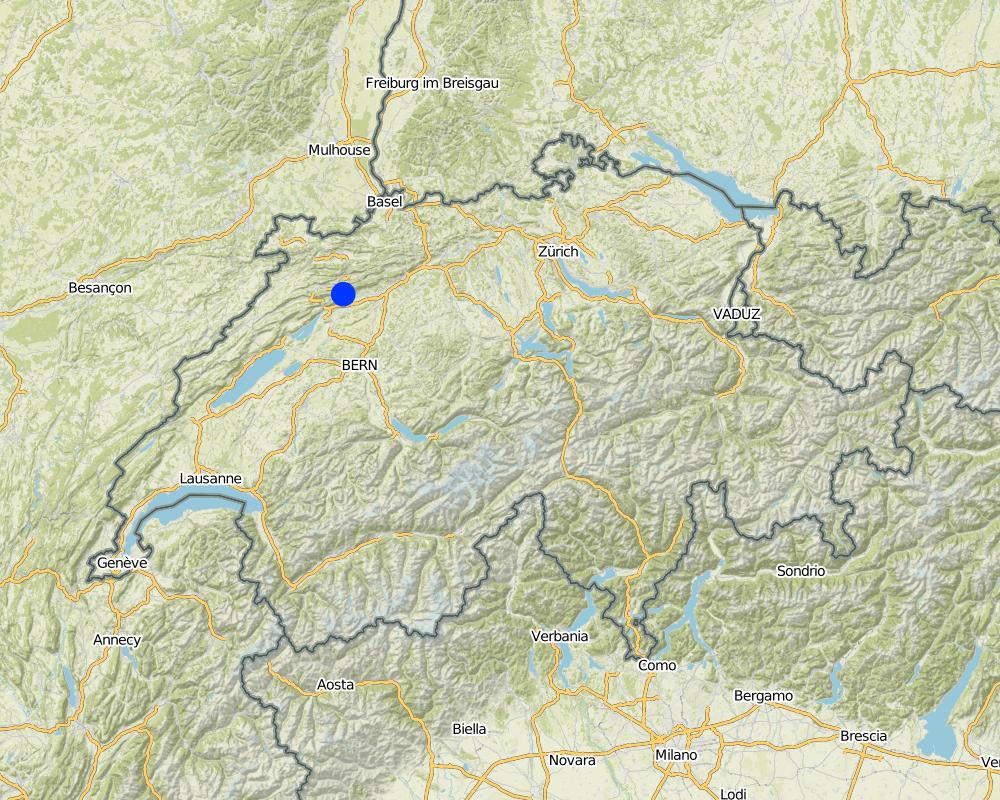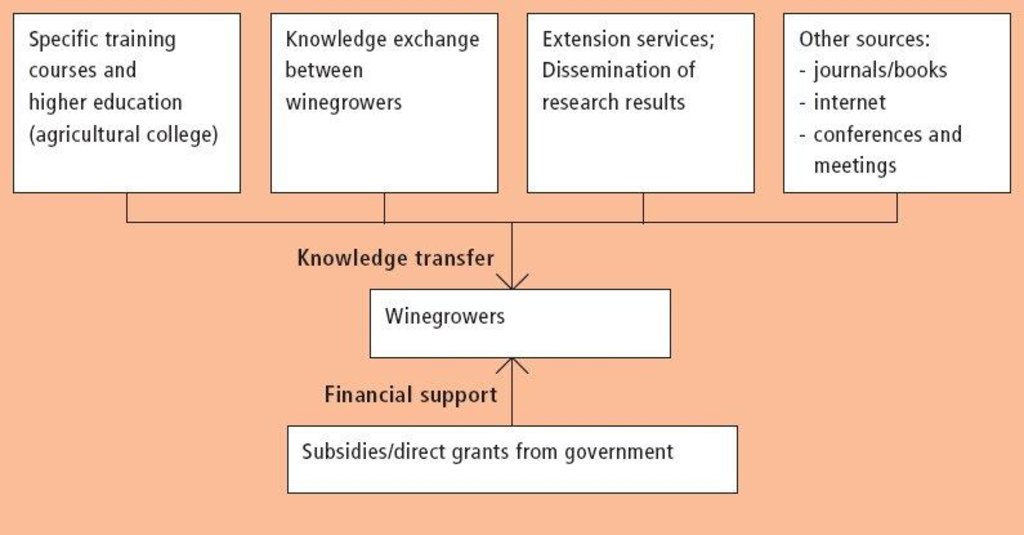Farmer initiative within enabling environment [ສະວິດເຊີແລນ]
- ການສ້າງ:
- ປັບປູງ:
- ຜູ້ສັງລວມຂໍ້ມູນ: Nicole Guedel
- ບັນນາທິການ: –
- ຜູ້ທົບທວນຄືນ: David Streiff, Deborah Niggli
approaches_2623 - ສະວິດເຊີແລນ
ເບິ່ງພາກສ່ວນ
ຂະຫຍາຍທັງໝົດ ຍຸບທັງໝົດ1. ຂໍ້ມູນທົ່ວໄປ
1.2 ລາຍລະອຽດ ການຕິດຕໍ່ ຂອງບຸກຄົນທີ່ຊັບພະຍາກອນ ແລະ ສະຖາບັນ ການມີສ່ວນຮ່ວມ ໃນການປະເມີນຜົນ ແລະ ເອກະສານ ຂອງວິທີທາງ
ຊື່ຂອງໂຄງການ ທີ່ອໍານວຍຄວາມສະດວກ ໃນການສ້າງເອກກະສານ ຫຼື ປະເມີນດ້ານແນວທາງ (ຖ້າກ່ຽວຂ້ອງ)
Book project: where the land is greener - Case Studies and Analysis of Soil and Water Conservation Initiatives Worldwide (where the land is greener)ຊື່ຂອງ ສະຖາບັນການຈັດຕັ້ງ ທີ່ອໍານວຍຄວາມສະດວກ ໃນການສ້າງເອກກະສານ ຫຼື ປະເມີນແນວທາງ (ຖ້າກ່ຽວຂ້ອງ)
CDE Centre for Development and Environment (CDE Centre for Development and Environment) - ສະວິດເຊີແລນ1.3 ເງື່ອນໄຂ ຂອງການນໍາໃຊ້ເອກກະສານຂໍ້ມູນ ຂອງ WOCAT
ຜູ້ສັງລວມ ແລະ ບັນດາຜູ້ຕອບແບບສອບຖາມ ຍອມຮັບໃນເງື່ອນໄຂ ການນໍາໃຊ້ຂໍ້ມູນເອກະສານ ທີ່ສ້າງຂື້ນ ໂດຍຜ່ານ ອົງການ WOCAT:
ແມ່ນ
1.4 ເອກະສານອ້າງອີງ (ຫຼາຍ) ກັບແບບສອບຖາມ (ຫຼາຍ) ເຕັກໂນໂລຢີ ຂອງດ້ານການຄຸ້ມຄອງ ດິນແບບຍືນຍົງ
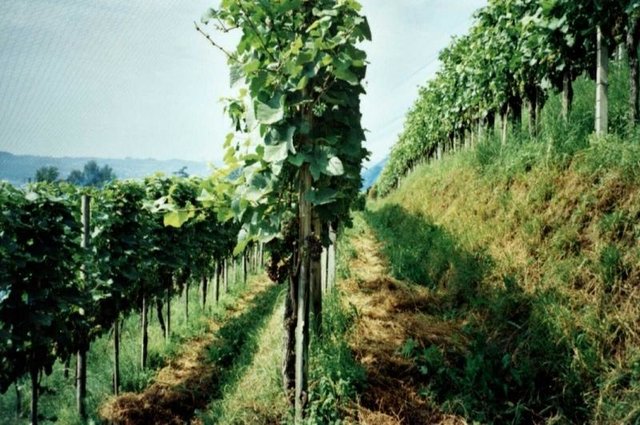
Contour small bench terraces with permanent green cover … [ສະວິດເຊີແລນ]
Contour small bench terraces with stabilising permanent green cover in steep sloping vineyards.
- ຜູ້ສັງລວມຂໍ້ມູນ: Nicole Guedel
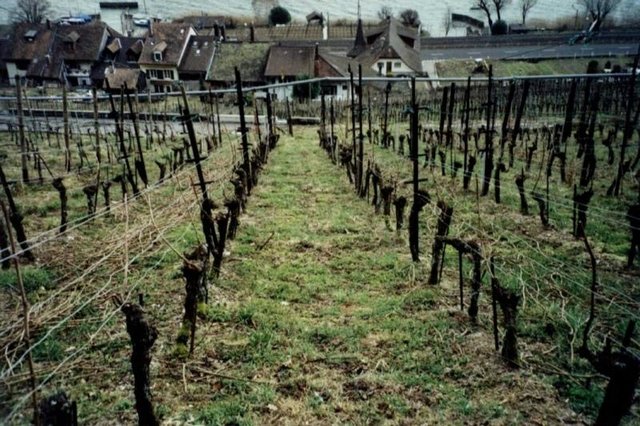
Green cover in vineyards [ສະວິດເຊີແລນ]
Naturally growing or sown perennial grasses/herbs providing cover between rows in sloping vineyards, where the vines are usually oriented up and down slope.
- ຜູ້ສັງລວມຂໍ້ມູນ: Nicole Guedel
2. ພັນລະນາ ແນວທາງການຄຸ້ມຄອງນໍາໃຊ້ດິນແບບຍືນຍົງ
2.1 ການອະທິບາຍ ໂດຍຫຍໍ້ ຂອງວິທີທາງ
Initiative and innovation of land users, stimulated by government's technical and financial support.
2.2 ການອະທິບາຍ ລາຍລະອຽດ ຂອງວິທີທາງ
ການອະທິບາຍ ລາຍລະອຽດ ຂອງວິທີທາງ:
Aims / objectives: The application of green cover (a ???living mulch??? between vine rows) in viniculture within the case study area has been developed and spread, primarily, by experimentation and exchange of knowledge between winegrowers. Individual initiatives and personal contacts have been the most important elements. Other channels are: (1) higher education and specific training courses (the majority of winegrowers have undergone at least 3 years of agricultural college, including both applied and theoretical training); (2) participation in conferences and meetings; (3) self-teaching using the internet and national and international journals or books; and (4) extension services. Disseminated results from national research institutions also play an important role - over and above individual knowledge and experimentation. The approach is thus characterised by responsiveness of winegrowers to the various information sources listed above. This should be seen in the context of national agricultural policy which provides an ???enabling environment??? including payments to farmers: the production quotas of the 1950s were replaced in 2001 by direct grants (subsidies) based on area grown and/or other specific criteria, eg ecological services such as green cover. However, the technology of green cover spread spontaneously before direct incentives were tied to ???ecological production???. Government policy supports agriculture as a weak sector of the national economy, and guarantees, through subsidies, a high percentage of the overall national production. Subsidies in Swiss agriculture are amongst the highest in the world. These subsidies effectively keep wine production going. Vineyards are seen as an important part of the rural cultural heritage and as a characteristic feature of the landscape.
Methods: Recently, with this type of production system, there has emerged a further opportunity - to market wine under a label of controlled ecological production (???vinatura???). A step further is the label of ???organic production??? which, in addition to green cover, requires a range of other criteria to be strictly fulfilled (eg no use of chemical fertilizers/biocides). Customers are increasingly willing to pay a premium for such products. This is an example of a win-win situation: the environment is protected and simultaneously farmers are rewarded with a higher value for their output. Within the framework of subsidies to farmers and information availability, the ???approach??? to improved viniculture can therefore be viewed as an enabling environment for land users to take initiatives themselves. The diffusion of innovative technologies is also largely left to the land users.
2.3 ຮູບພາບຂອງແນວທາງ
2.5 ປະເທດ / ເຂດ / ສະຖານທີ່ບ່ອນທີ່ແນວທາງໄດ້ຖືກນໍາໃຊ້
ປະເທດ:
ສະວິດເຊີແລນ
ພາກພື້ນ / ລັດ / ແຂວງ:
Swiss viniculture area
ຂໍ້ມູນເພີ່ມເຕີມຂອງສະຖານທີ່:
Switzerland
ຄວາມຄິດເຫັນ:
The approach is not limited to the SWC technology area described in QT SWI01 and SWI02. It is rather representative for Switzerland.
Map
×2.7 ປະເພດຂອງແນວທາງ
- ພື້ນເມືອງ / ທ້ອງຖີ່ນ
2.8 ເປົ້າໝາຍ / ຈຸດປະສົງຫຼັກ ຂອງການຈັດຕັ້ງປະຕິບັດ ວິທີທາງ
The Approach focused mainly on other activities than SLM (viticulture as whole and its basic conditions (production of wine, financial questions, economy, technical aspects, equipment, ecology, viticulture and tourism))
The overall objective of national policy is, within a framework of subsidies, to allow farmers to develop and spread solutions themselves through access to sources of knowledge and information. The objectives of the farmers themselves are to improve their production systems through ecologically sound conservation.
The SLM Approach addressed the following problems: - initial technical problem of soil degradation within vineyards: no off the shelf solutions - slow spread of technical solutions (such as green cover which requires fundamental changes in land users attitudes)
2.9 ເງື່ອນໄຂອໍານວຍ ຫຼື ຂັດຂວາງການປະຕິບັດຂອງເຕັກໂນໂລຢີ / ເຕັກໂນໂລຢີການນໍາໃຊ້ຕາມແນວທາງ
ສັງຄົມ / ວັດທະນະທໍາ / ມາດຕະຖານ ແລະ ຄຸນຄ່າທາງສາສະໜາ
- ເຊື່ອງຊ້ອນ
In a community of winegrowers who are used to either clean tillage (traditional method) or chemical weeding, green cover implies a change of values and priorities. This can cause conflicts especially between neighbours and within families
Treatment through the SLM Approach: First, rising awareness of advantages and possible disadvantages of green cover by (further) education, literature, meetings / conferences and internet by research institutions and extension services. The second step is conflict resolution on a one-to-one
ຄວາມຮູ້ກ່ຽວກັບການຄຸ້ມຄອງ ທີ່ດິນແບບຍືນຍົງ, ການເຂົ້າເຖິງການສະໜັບສະໜູນ ທາງດ້ານວິຊາການ
- ເຊື່ອງຊ້ອນ
The implementation of green cover is strongly dependent on factors on farm or parcel level (available infrastructure / equipment, age of vines, planting system (density and distance of vines, characteristics of supporting elements, poles, wire system...))
Treatment through the SLM Approach: Individual consultation with extension service where specific advice required
ອື່ນໆ
- ເຊື່ອງຊ້ອນ
Natural environment: Climatic (drought, frost) and pedological (soil depth) factors can intensify water and nutrient competition to the vine, danger of frost and therefore hamper the implementation of green cover.
Treatment through the SLM Approach: Information provided by mentioned sources. Examples of possible solutions: Green cover on every second interrow; green cover only in winter; agronomic measures to temporarily eliminate competition of cover vegetation (by cutting / mulching vegetation or r
3. ການມີສ່ວນຮ່ວມ ແລະ ບົດບາດຂອງພາກສ່ວນທີ່ກ່ຽວຂ້ອງທີ່ໄດ້ມີສ່ວນຮ່ວມ
3.1 ຜູ້ມີສ່ວນຮ່ວມ ໃນວິທີທາງ ແລະ ພາລະບົດບາດ ຂອງເຂົາເຈົ້າ
- ຜູ້ນໍາໃຊ້ດິນໃນທ້ອງຖິ່ນ / ຊຸມຊົນທ້ອງຖິ່ນ
land user themselves (their network, exchange of knowledge, implementation)
Existing groups of land users
Working land users were mainly men (because the majority of Swiss winegrowers are men)
The integration of women is a key element of the approach. Nevertheless, there are moderate differences due to cultural factors: men are mainly in charge of agricultural activities, whereas women work in the household.
- ອໍານາດ ການປົກຄອງທ້ອງຖິ່ນ
Districts, communities, villages
- ພະນັກງານຂັ້ນສູນກາງ (ຜູ້ວາງແຜນ, ຜູ້ສ້າງນະໂຍບາຍ)
3.2 ການມີສ່ວນຮ່ວມຂອງຜູ້ນໍາໃຊ້ທີ່ດິນໃນທ້ອງຖິ່ນ / ຊຸມຊົນທ້ອງຖິ່ນໃນໄລຍະທີ່ແຕກຕ່າງກັນຂອງແນວທາງ
| ການລວບລວມ ເອົາຜູ້ນໍາໃຊ້ດິນ ໃນທ້ອງຖິ່ນ / ຊຸມຊົນທ້ອງຖິ່ນ | ໃຫ້ລະບຸ ຜູ້ໃດທີ່ມີສ່ວນຮ່ວມ ໃນແຕ່ລະກິດຈະກໍາ? | |
|---|---|---|
| ການເລີ່ມຕົ້ນ / ແຮງຈູງໃຈ | ການນໍາໃໍຊ້ເອງ | |
| ການວາງແຜນ | ການຮ່ວມມື | the basic idea was further enhanced by planning based on available information from various sources |
| ການປະຕິບັດ | ການນໍາໃໍຊ້ເອງ | responsibility for major steps; Responsibility of winegrowers of all steps |
| ຕິດຕາມກວດກາ / ການປະເມີນຜົນ | ການນໍາໃໍຊ້ເອງ | Mainly: measurements/observations; partly: workshop/seminars, public meetings, reporting; Observation by land user. Some indicators are evaluated by extension services or research institutions. |
| Research | ການຮ່ວມມື | on-station; Both on-farm and on-station |
3.3 ແຜນວາດ (ຖ້າມີ)
3.4 ການຕັດສິນໃຈກ່ຽວກັບການຄັດເລືອກເຕັກໂນໂລຢີຂອງການຄຸ້ມຄອງທີ່ດິນແບບຍືນຍົງ / ເຕັກໂນໂລຢີ
ລະບຸ ຄົນທີ່ຕັດສິນໃຈ ກ່ຽວກັບການຄັດເລືອກຂອງ ເຕັກໂນໂລຢີ / ເຕັກໂນໂລຢີ ຈະໄດ້ຮັບການປະຕິບັດ:
- ຜູ້ນໍາໃຊ້ດິນຜູ້ດຽວ (ການລິເລີ່ມດ້ວຍຕົນເອງ)
ອະທິບາຍ:
Decisions on the method of implementing the SLM Technology were made by by land users* alone (self-initiative / bottom-up)
4. ການສະໜັບສະໜູນທາງດ້ານວິຊາການ, ການສ້າງຄວາມສາມາດ, ແລະ ການຈັດການຄວາມຮູ້.
4.1 ການສ້າງຄວາມສາມາດ / ການຝຶກອົບຮົມ
ຜູ້ນໍາໃຊ້ທີ່ດິນ ຫຼື ພາກສ່ວນກ່ຽວຂ້ອງອື່ນໆ ໄດ້ຮັບການຝຶກອົບຮົມບໍ່?
ແມ່ນ
ຮູບແບບຂອງການຝຶກອົບຮົມ:
- ການເຮັດຕົວຈິງ
- ຕົວຕໍ່ຕົວ
- ເນື້ອທີ່ສວນທົດລອງ
- ກອງປະຊຸມ
- ຫຼັກສູດ
ໃນຫົວຂໍ້:
There are various possibilities which include green cover as one of several topics: (1) agricultural college (three years, including both practical and theoretical knowledge); (2) further education (full time or short courses) at agricultural universities; (3) attendance at regional, national or international meetings/conferences, organised by research institutions, extension services, or
4.2 ການບໍລິການໃຫ້ຄໍາປຶກສາ
ເຮັດຜູ້ໃຊ້ທີ່ດິນມີການເຂົ້າເຖິງການບໍລິການໃຫ້ຄໍາປຶກສາ?
ແມ່ນ
ລະບຸວ່າການສະໜອງ ການບໍລິການ ໃຫ້ຄໍາປຶກສາ:
- ໃນພື້ນທີ່ຂອງຜູ້ນໍາໃຊ້ດິນ
ອະທິບາຍ / ຄວາມຄິດເຫັນ:
Adoption; Key elements: palette of information sources, informal contacts, discussions, observations of different systems under personal trials.1) Advisory service was carried out through: non-governmental agency, government's existing extension system 2) Advisory service was carried out through: non-governmental agency, government's existing extension system; Extension staff: mainly government employees
Advisory service is very adequate to ensure the continuation of land conservation activities
4.3 ສະຖາບັນການສ້າງຄວາມເຂັ້ມແຂງ (ການພັດທະນາອົງການຈັດຕັ້ງ)
ສະຖາບັນ ໄດ້ຮັບການສ້າງຕັ້ງຂື້ນ ຫຼື ໄດ້ຮັບການສ້າງຄວາມເຂັ້ມແຂງ ໂດຍການຈັດຕັ້ງປະຕິບັດ ວິທີທາງບໍ່?
- ບໍ່ມີ
4.4 ຕິດຕາມກວດກາ ແລະ ປະເມີນຜົນ
ການຈັດຕັ້ງປະຕິບັດ ວິທີທາງ ໄດ້ມີການປະເມີນຜົນ ແລະ ຕິດຕາມບໍ?
ແມ່ນ
ຄວາມຄິດເຫັນ:
bio-physical aspects were ad hoc monitored by land users, other through observations; indicators: rate of erosion, organic matter content, soil moisture, water potential in vine leaves, compaction, soil structure, soil temperature, biodiversity, chemical analysis of wine, nutrient elements in soil and vines
technical aspects were ad hoc monitored by land users, other through observations; indicators: change of attitude towards green cover, knowledge about SWC and awareness of natural environment, change of appearance of man-made landscape
socio-cultural aspects were ad hoc monitored by land users, other through observations; indicators: costs, production, quality, manual labour, machine hours etc. Often data are not specifically gathered for green cover but total establishment and annual recurrent costs for different winegrowing systems can give some insight into the economic status of green cover
economic / production aspects were ad hoc monitored by land users through observations; indicators: diffusion of green cover (visual impression of the current status, time-series photos, descriptions from past)
area treated aspects were ad hoc monitored by 0 through observations; indicators: number of households involved (with a questionnaire, personal estimation, visual impressions), Number of farmers receiving direct payments
no. of land users involved aspects were ad hoc monitored by other through observations; indicators: None
There were few changes in the Approach as a result of monitoring and evaluation: Few changes to the technology or the approach have resulted directly from formal monitoring and evaluation.
4.5 ການຄົ້ນຄວ້າ
ນີ້້ແມ່ນສ່ວນໜຶ່ງ ການຄົ້ນຄວ້າ ຂອງວິທີທາງບໍ່?
ແມ່ນ
ໃຫ້ຂໍ້ມູນ ເພີ່ມເຕີມ ແລະ ກໍານົດ ຜູ້ໃດເຮັດການຄົ້ນຄວ້າ:
Especially ecological and technical aspects are important elements of the research institutions concerning SWC: e.g. management of green cover such as dealing with competition of water and nutrients to the vine or promoting living space for animals (especially insects) beneficial to grape production (e.g. promoting predators of pests as a possibility of biological pest control). But also economic
Research was carried out both on station and on-farm
5. ການສະໜັບສະໜູນທາງດ້ານການເງິນ ແລະ ອຸປະກອນຈາກພາຍນອກ
5.1 ງົບປະມານປະຈໍາປີ ສໍາລັບວິທີທາງ ຂອງການຄຸ້ມຄອງ ທີ່ດິນແບບຍືນຍົງ
ຄໍາເຫັນ (ຕົວຢ່າງ: ແຫຼ່ງຂໍ້ມູນຫຼັກ ຂອງການສະໜອງທຶນ / ຜູ້ໃຫ້ທຶນທີ່ສໍາຄັນ):
Approach costs were met by the following donors: government (national): 70.0%; local community / land user(s) (-): 30.0%
5.2 ການສະໜັບສະໜູນ ທາງດ້ານການເງິນ / ອຸປະກອນ ສະໜອງໃຫ້ແກ່ຜູ້ນໍາທີ່ດິນ
ຜູ້ນໍາໃຊ້ດິນ ໄດ້ຮັບການສະໜັບສະໜູນ ທາງດ້ານ ການເງິນ / ອຸປະກອນ ໃນການຈັດຕັ້ງປະຕິບັດ ເຕັກໂນໂລຢີບໍ?
ແມ່ນ
5.3 ເງິນສົມທົບສໍາລັບການນໍາໃຊ້ສະເພາະປັດໃຈຂາເຂົ້າໃນການຜະລີດກະສິກໍາ (ລວມທັງແຮງງານ)
ຖ້າແຮງງານ ຂອງຜູ້ນໍາໃຊ້ດິນ ໄດ້ຮັບການສະໜັບສະໜູນ ປັດໃຈຂາເຂົ້າ, ແມ່ນບໍ່:
- ການອາສາ
ຄວາມຄິດເຫັນ:
Labour is a substantial input and exclusively done voluntary by land users - though the overall agricultural system is subsidised
5.4 ສິນເຊື່ອ
ໄດ້ປ່ອຍສິນເຊື່ອ ສະໜອງໃຫ້ພາຍໃຕ້ ວິທີການສໍາລັບກິດຈະກໍາ ການຄຸ້ມຄອງ ທີ່ດິນແບບຍືນນຍົງບໍ່?
ບໍ່ແມ່ນ
6. ວິເຄາະຜົນກະທົບ ແລະ ສັງລວມບັນຫາ
6.1 ຜົນກະທົບຂອງແນວທາງ
ການຈັດຕັ້ງປະຕິບັດ ວິທີທາງ ສາມາດຊ່ວຍຜູ້ນໍາໃຊ້ທີ່ດິນ ໃນການຈັດຕັ້ງປະຕິບັດ ແລະ ບໍາລຸງຮັກສາ ເຕັກໂນໂລຢີ ການຄຸ້ມຄອງ ທີ່ດິນແບບຍືນຍົງໄດ້ບໍ?
- ບໍ່
- ມີ, ໜ້ອຍໜຶ່ງ
- ມີ, ພໍສົມຄວນ
- ມີ, ຫຼາຍ
The approach (with all its elements) has led to greatly improved soil and water management.
6.3 ຄວາມຍືນຍົງຂອງກິດຈະກໍາວິທີທາງ
ຜູ້ນໍາໃຊ້ ທີ່ດິນ ສາມາດສືບຕໍ່ ການຈັດຕັ້ງປະຕິບັດ ຜ່ານວິທີທາງໄດ້ບໍ່ (ໂດຍປາດສະຈາກ ການຊ່ວຍເຫຼືອ ຈາກພາກສ່ວນພາຍນອກ)?
- ແມ່ນ
ຖ້າ ໄດ້, ອະທິບາຍເຫດຜົນ:
Within the framework of the existing national policies the approach is sustainable.
6.4 ຈຸດແຂງ / ຂໍ້ດີ ຂອງວິທີທາງ
| ຈຸດແຂງ / ຈຸດດີ / ໂອກາດ ຈາກທັດສະນະຂອງຜູ້ປ້ອນຂໍ້ມູນ ຫຼື ບຸກຄົນສຳຄັນ |
|---|
| Very bottom-up oriented. The interest, the own initiative and the generation of own experience and knowledge is the dominant motor (How to sustain/ enhance this strength: Maintain the enabling environment put in place by the government which is the framework for this approach.) |
| Many information sources and ways of receiving information are available and used frequently. |
6.5 ຈຸດອ່ອນ / ຂໍ້ເສຍຂອງແນວທາງ ແລະ ວິທີການແກ້ໄຂໃຫ້ເຂົາເຈົ້າ
| ຈຸດອ່ອນ ຫຼື ຂໍ້ເສຍ ຫຼື ຄວາມສ່ຽງ ໃນມຸມມອງຂອງ ຜູ້ສັງລວມຂໍ້ມູນ ຫຼື ບັນດາຜູ້ຕອບແບບສອບຖາມ | ມີວິທີການແກ້ໄຂຄືແນວໃດ? |
|---|---|
| Winegrowing as a whole is highly dependent on financial incentives. Without direct payments, continuation of Swiss winegrowing and therefore green cover would be threatened ??¡§ at least under marginal conditions | Continue the incentive policy (though this may conflict with international efforts to reduce farm subsidies worldwide). |
7. ເອກກະສານອ້າງອີງ ແລະ ຂໍ້ມູນການເຊື່ອມໂຍງ
7.1 ວິທີການ / ແຫຼ່ງຂໍ້ມູນ
- ການໄປຢ້ຽມຢາມພາກສະໜາມ, ການສໍາຫຼວດພາກສະໜາມ
- ການສໍາພາດ ຜູ້ນໍາໃຊ້ທີ່ດິນ
7.2 ເອກະສານທົ່ວໄປທີ່ສາມາດໃຊ້ໄດ້
ຫົວຂໍ້, ຜູ້ຂຽນ, ປີ, ISBN:
Guedel N (2003) Boden- und Wasserkonservierung in Schweizer Rebbergen. Ein Beispiel im Rahmen von WOCAT. Unpublished
ມີຢູ່ໃສ?ມູນຄ່າເທົ່າໃດ?
Centre for Development and Environment, University of Berne
ຂໍ້ມູນການເຊື່ອມຕໍ່ ແລະ ເນື້ອໃນ
ຂະຫຍາຍທັງໝົດ ຍຸບທັງໝົດການເຊື່ອມຕໍ່

Contour small bench terraces with permanent green cover … [ສະວິດເຊີແລນ]
Contour small bench terraces with stabilising permanent green cover in steep sloping vineyards.
- ຜູ້ສັງລວມຂໍ້ມູນ: Nicole Guedel

Green cover in vineyards [ສະວິດເຊີແລນ]
Naturally growing or sown perennial grasses/herbs providing cover between rows in sloping vineyards, where the vines are usually oriented up and down slope.
- ຜູ້ສັງລວມຂໍ້ມູນ: Nicole Guedel
ເນື້ອໃນ
ບໍ່ມີເນື້ອໃນ


